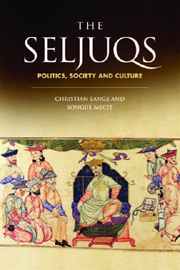Book contents
- Frontmatter
- Contents
- List of figures
- Acknowledgements
- List of abbreviations
- INTRODUCTION
- PART I POLITICS
- PART II SOCIETY
- Part III CULTURE
- 11 SHIˁI JURISPRUDENCE DURING THE SELJUQ PERIOD: REBELLION AND PUBLIC ORDER IN AN ILLEGITIMATE STATE
- 12 IN DEFENCE OF SUNNISM: AL-GHAZĀLĪ AND THE SELJUQS
- 13 ARABIC AND PERSIAN INTERTEXTUALITY IN THE SELJUQ PERIOD: ḤAMĪDĪ'S MAQĀMĀT AS A CASE STUDY
- 14 CITY BUILDING IN SELJUQ RUM
- 15 THE SELJUQ MONUMENTS OF TURKMENISTAN
- Index
15 - THE SELJUQ MONUMENTS OF TURKMENISTAN
from Part III - CULTURE
Published online by Cambridge University Press: 12 September 2012
- Frontmatter
- Contents
- List of figures
- Acknowledgements
- List of abbreviations
- INTRODUCTION
- PART I POLITICS
- PART II SOCIETY
- Part III CULTURE
- 11 SHIˁI JURISPRUDENCE DURING THE SELJUQ PERIOD: REBELLION AND PUBLIC ORDER IN AN ILLEGITIMATE STATE
- 12 IN DEFENCE OF SUNNISM: AL-GHAZĀLĪ AND THE SELJUQS
- 13 ARABIC AND PERSIAN INTERTEXTUALITY IN THE SELJUQ PERIOD: ḤAMĪDĪ'S MAQĀMĀT AS A CASE STUDY
- 14 CITY BUILDING IN SELJUQ RUM
- 15 THE SELJUQ MONUMENTS OF TURKMENISTAN
- Index
Summary
This chapter discusses a compact body of high-quality medieval monuments from Turkmenistan. In order to say something worthwhile in the limited space available, it seems sensible to deal swiftly with the geographical setting, the distribution of these monuments in time and space, and their political context. The bulk of this chapter will then focus on their structural features and on their place within the wider framework of architecture in the Iranian world in this period. In that context, the thrust of the argument will be that the 5th to 6th-/11th to 12th-century monuments in modern Turkmenistan constitute a distinct local school of Seljuq architecture, with a recognisable repertoire of forms and style of decoration. The chapter will end with a brief assessment of the major building of the whole school, the building popularly known as the mausoleum of Sultan Sanjar.
SETTING
First, then, the geographical and physical setting. A brief glance at a map is enough to show that the modern state of Turkmenistan possesses clear natural boundaries to the south, east and west. These are, respectively, the Köpet Dāgh range of mountains which separates it from Iran; the River Oxus, or Āmū Daryā, with modern Uzbekistan on its other bank; and the Caspian Sea. Only to the north, where lies Kazakhstan, is there no natural barrier. In contrast to Iran, which lies directly to the south, Turkmenistan is not a plateau but lies for the most part barely above sea level. Most of Turkmenistan, in fact, comprises deserts of notable severity, of which the Kara Kum is the most famous.
- Type
- Chapter
- Information
- The SeljuqsPolitics, Society and Culture, pp. 277 - 308Publisher: Edinburgh University PressPrint publication year: 2011



